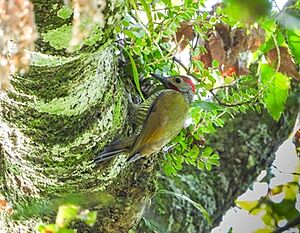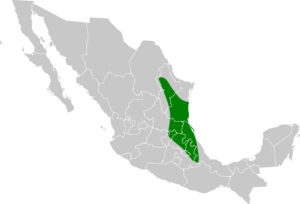Bronze-winged woodpecker facts for kids
Quick facts for kids Bronze-winged woodpecker |
|
|---|---|
 |
|
| Conservation status | |
| Scientific classification | |
| Genus: |
Colaptes
|
| Species: |
aeruginosus
|
 |
|
| Synonyms | |
|
Colaptes rubiginosus aeruginosus |
|
The bronze-winged woodpecker (Colaptes aeruginosus) is a fascinating bird from the woodpecker family. It is special because it lives only in northeastern Mexico.
Contents
How Scientists Classify This Bird
Scientists who study birds, called ornithologists, sometimes have different ideas about how to group them. The bronze-winged woodpecker was first named Chrysopicus aeruginosus. Later, it was placed in a group called Piculus.
Around 2007, most scientists agreed to move it into the Colaptes group. Some groups, like the International Ornithological Committee, see it as its own unique species. Others, like the American Ornithological Society, think it's a type of golden-olive woodpecker.
This woodpecker is considered "monotypic." This means it does not have any different subspecies or types within its own species.
What Does the Bronze-Winged Woodpecker Look Like?
This woodpecker is about 18 to 23 centimeters (7 to 9 inches) long. Both male and female birds look very similar. The main differences are found on their heads.
Male and Female Differences
- Males have a gray forehead and the top of their head. This gray area has a red border that goes from above their eye to the back of their neck. They also have a wide red stripe on their cheek. Their chin and upper throat are pale, with dark streaks.
- Females only have red on the back of their neck. They do not have the red on their head or the red cheek stripe.
General Appearance
Both male and female woodpeckers have mostly green upper parts. These parts have a cool bronze shine. Their lower back and tail feathers are lighter and have dark olive stripes.
Their flight feathers, which they use for flying, are dark brownish-olive. They have greenish edges and some yellow on the feather shafts. Their tail is brown.
The underside of their body is a pale yellowish color. It has blackish-olive bars that look like scales. Their beak is a medium length and is gray to black. Their eyes are a deep dull red, and their legs are gray or olive-gray.
Young Woodpeckers
Young bronze-winged woodpeckers look a bit duller than the adults. The stripes on their underside are also not as clear or well-defined.
Where Do They Live?
The bronze-winged woodpecker lives in eastern Mexico. You can find them in states like Tamaulipas and Veracruz.
They like to live in certain types of places:
- Subtropical dry forests
- Forests that are growing back after being cut down (secondary forests)
- Plantations, which are areas where trees are grown for specific purposes
These birds can be found from sea level up to about 2,100 meters (6,900 feet) high.
How Do They Behave?
Movement and Home
As far as we know, the bronze-winged woodpecker stays in the same area all year long. It does not migrate to different places.
What Do They Eat?
Scientists have not studied the bronze-winged woodpecker's eating habits separately. They believe it eats similar things and uses similar methods as the golden-olive woodpecker. This usually means they eat insects found in trees.
Breeding and Nests
The bronze-winged woodpecker's breeding season is from January to May. Like their feeding habits, more detailed information about their breeding is often grouped with the golden-olive woodpecker. Woodpeckers typically nest in holes they carve into trees.
What Do They Sound Like?
The song of the bronze-winged woodpecker is a slow series of high-pitched calls. It sounds like "kwi, kwi, kwi, kwi, kwi, kwi." This song is quite different from the "rising rattling trill" sound made by the golden-olive woodpecker.
How Are They Doing?
The IUCN (International Union for Conservation of Nature) has looked at the bronze-winged woodpecker's situation. They have assessed it as being of "Least Concern." This means that the bird is not currently in danger of extinction.
It lives across a large area. Even though we don't know the exact number of these birds, their population is thought to be stable. Scientists have not found any immediate threats that would put this species at risk.


